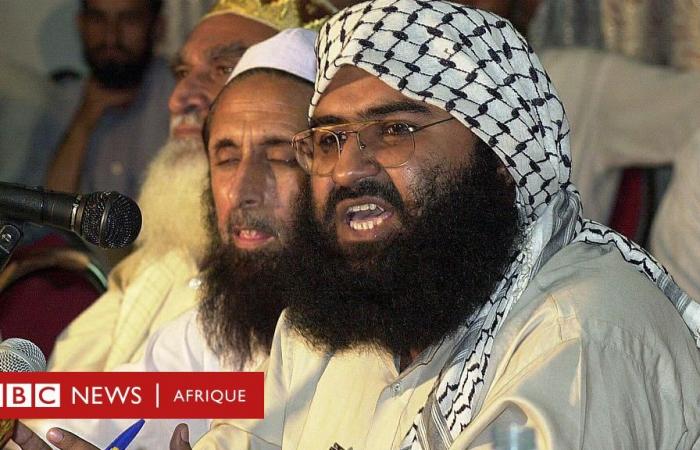Photo credit, SAEED KHAN/AFP via Getty Images
- Author, BBC Urdu
- Role,
-
32 minutes ago
At the start of the week, India launched missile strikes on nine sites in Pakistan, in response to a deadly militant attack against Indian tourists in cashmere two weeks ago, which killed 26 people.
She said that these sites were “terrorist infrastructure” and that she had targeted the Subhanullah mosque in the Bahawalpur region, in eastern Pakistan, which the Indian authorities have described as a “recruitment and military and ideological training center” by the militant group prohibited Jaish-e-Mohammed (Jem).
What is this prohibited organization and which is its leader, Masood Azhar – designated as a terrorist by the United Nations – who declared that the attack had killed a large number of his relatives?
Who is Masood Azhar?
Masood Azhar is known worldwide as a radical who has influenced Muslims around the world to commit murders and other acts of terror under the banner of jihad (“Holy War”).
He was born in 1968 into a religious family in the city of Bahawalpur. His father worked in the field of medicine and philosophy.
After his primary studies, he continued his studies at the Jamia Uloom-Ulo-Ul-Islamia, an Islamic university located in Banoori, Karachi-the largest city in Pakistan. After graduating, he was appointed teacher to Jamia Banoori, a religious institution.
According to Tahir Hameed, a close collaborator quoted in Risaal-E-Jihad, a militant magazine, Masood Azhar spent time in Afghanistan to fight with jihadists (Islamist combatants) in 1989.
After his return from Afghanistan, Masood Azhar continued to call for violence in other regions, especially in the cities of Karachi, Hyderabad, Sukkur, Khupru, Nawabshah and others.
He also wrote articles to express his opinions and promote violent jihad and, in January 1990, he published the first issue of the monthly magazine Sadae Mujahid (“Voix du Mujahid” or Islamist militant).
This magazine would have been influenced by the Harkat-U-Mujahideen, a former Pakistani militant group (now disappeared) operating in Cashmere, and would have followed the theological interpretations of the group.
Masood Azhar wrote more than 30 books on Islamic jihad, history, training and management of jihadists, stressing the importance of fighting in Afghanistan to defend Islamist ideals, according to journalists and experts.
Arrest and release in India
Masood Azhar believed in violent jihad on a global scale. He went to India, Bangladesh, Saudi Arabia and Zambia, as well as in the United Kingdom, according to some of his associates. In 1994, he was arrested in cashmere under Indian administration, accused by India of being involved in terrorist activities.
In a statement made to the Indian intelligence agency CBI during its detention, Masood Azhar said that he went to India to assess the possibilities of “jihad” in this country, according to the media of the time. He first went to Bangladesh, then to Delhi, the Indian capital, with a Portuguese passport.
The name of Masood Azhar became famous when six foreign tourists were kidnapped in cashmere under Indian administration in 1995. The kidnappers named Al Faran and demanded its release, which the Indian government refused.
-It is believed that five of the tourists were killed, while another managed to escape.
On December 24, 1999, an Indian Airlines plane connecting Kathmandu, the Nepalese capital, in Delhi was diverted. The plane landed in Kandahar, Afghanistan, where the Taliban (intransigent Islamist group) were in power.
The air pirates demanded the release of Masood Azhar in exchange for the release of the 155 passengers aboard the plane. After long negotiations, two other activists – Omar Saeed Sheikh and Mushtaq Zargar – were released at the same time as Masood Azhar.
Creation of Jaish-e-Mohammed
Photo credit, AFP via Getty Images
Before his arrest in India, Masood Azhar was part of the Harkat-U-Mujahideen. After his release, he announced the creation of Jaish-E-Mohammed (“The Army of Muhammad”) in Karachi in 1999.
He then broke up all relations with the Harkat-U-Mujahideen and, thereafter, the Jem captured several camps and offices belonging to the Harkat-U-Mujahideen.
In April 2000, a suicide bombing at the car trap was perpetrated against a military headquarters near Badami Bagh in Srinagar, the capital of Kashmir under Indian administration. It was the first suicide attack in the history of the cashmere movement. Indian authorities have attributed responsibility to Jaish-E-Mohammed.
The following year, in October, the Jammu-et-Cachemire assembly administered by India was attacked, and in December of the same year, the Indian Parliament in Delhi was also attacked, which India attributed to the Jem-which the Jem denies.
In 2016, India also accused the Jem of having perpetrated an attack on an air base in Pathankot, on the border between India and Pakistan.
India also held the Jem for responsible for the attack on the Indian consulate of Mazar-E-Sharif in Afghanistan and against the headquarters of the army brigade in Uri, the cashmere administered by India in 2016.
Three years later, in February 2019, the group said they had perpetrated a bomb attack on 40 soldiers in cashmere under Indian administration.
Registered on the list of terrorists
After the 2001 attack on the Indian Parliament, the United States scored Jaish-e-Mohammed on its list of foreign terrorist organizations (FTO).
India then tried to have the group designated as a global terrorist organization by the United Nations Security Council, but China has opposed its veto.
However, following a suicide bombing in Pulwama which killed 40 Indian soldiers in May 2019, the United Nations added the name of Masood Azhar to their list of world terrorists.
This attack led India and Pakistan to the edge of the total war, India having retaliated by air strikes to Balakot, which caused Pakistani raids in return and an air fight.
In 2002, under the regime of former President Pervez Musharraf, Jaish-E-Mohammed was prohibited, but the organization remained active under the name of Tanzeem al-Furqan and also created a social assistance organization called al-rahmat Trust.








